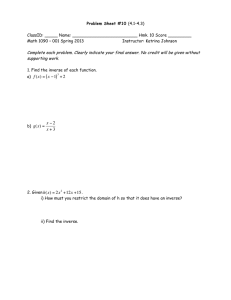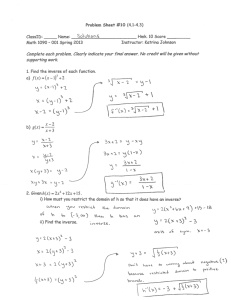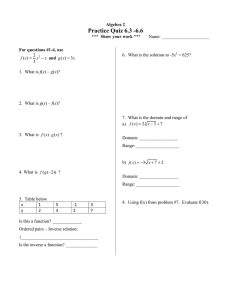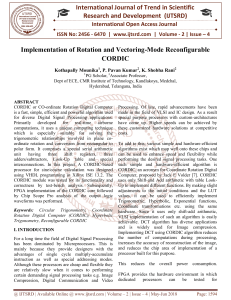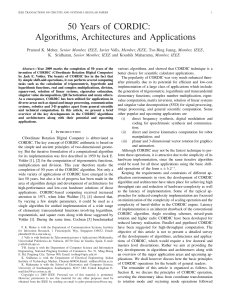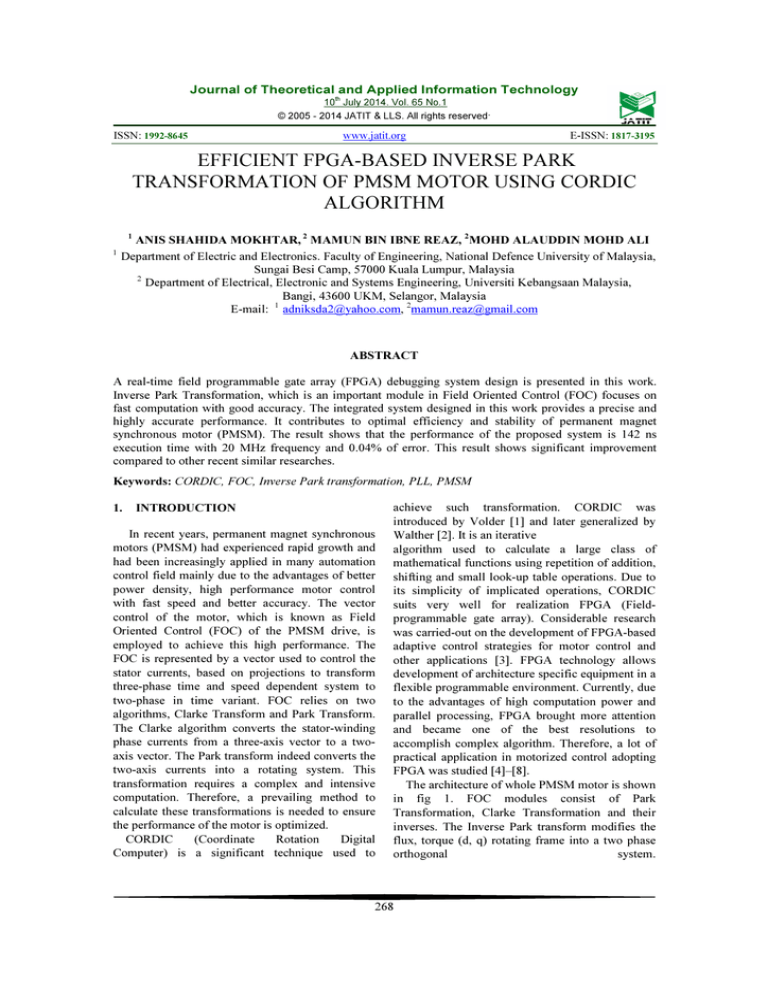
Journal of Theoretical and Applied Information Technology
10th July 2014. Vol. 65 No.1
© 2005 - 2014 JATIT & LLS. All rights reserved.
ISSN: 1992-8645
www.jatit.org
E-ISSN: 1817-3195
EFFICIENT FPGA-BASED INVERSE PARK
TRANSFORMATION OF PMSM MOTOR USING CORDIC
ALGORITHM
1
1
ANIS SHAHIDA MOKHTAR, 2 MAMUN BIN IBNE REAZ, 2MOHD ALAUDDIN MOHD ALI
Department of Electric and Electronics. Faculty of Engineering, National Defence University of Malaysia,
Sungai Besi Camp, 57000 Kuala Lumpur, Malaysia
2
Department of Electrical, Electronic and Systems Engineering, Universiti Kebangsaan Malaysia,
Bangi, 43600 UKM, Selangor, Malaysia
E-mail: 1 adniksda2@yahoo.com, 2mamun.reaz@gmail.com
ABSTRACT
A real-time field programmable gate array (FPGA) debugging system design is presented in this work.
Inverse Park Transformation, which is an important module in Field Oriented Control (FOC) focuses on
fast computation with good accuracy. The integrated system designed in this work provides a precise and
highly accurate performance. It contributes to optimal efficiency and stability of permanent magnet
synchronous motor (PMSM). The result shows that the performance of the proposed system is 142 ns
execution time with 20 MHz frequency and 0.04% of error. This result shows significant improvement
compared to other recent similar researches.
Keywords: CORDIC, FOC, Inverse Park transformation, PLL, PMSM
1.
INTRODUCTION
In recent years, permanent magnet synchronous
motors (PMSM) had experienced rapid growth and
had been increasingly applied in many automation
control field mainly due to the advantages of better
power density, high performance motor control
with fast speed and better accuracy. The vector
control of the motor, which is known as Field
Oriented Control (FOC) of the PMSM drive, is
employed to achieve this high performance. The
FOC is represented by a vector used to control the
stator currents, based on projections to transform
three-phase time and speed dependent system to
two-phase in time variant. FOC relies on two
algorithms, Clarke Transform and Park Transform.
The Clarke algorithm converts the stator-winding
phase currents from a three-axis vector to a twoaxis vector. The Park transform indeed converts the
two-axis currents into a rotating system. This
transformation requires a complex and intensive
computation. Therefore, a prevailing method to
calculate these transformations is needed to ensure
the performance of the motor is optimized.
CORDIC
(Coordinate
Rotation
Digital
Computer) is a significant technique used to
achieve such transformation. CORDIC was
introduced by Volder [1] and later generalized by
Walther [2]. It is an iterative
algorithm used to calculate a large class of
mathematical functions using repetition of addition,
shifting and small look-up table operations. Due to
its simplicity of implicated operations, CORDIC
suits very well for realization FPGA (Fieldprogrammable gate array). Considerable research
was carried-out on the development of FPGA-based
adaptive control strategies for motor control and
other applications [3]. FPGA technology allows
development of architecture specific equipment in a
flexible programmable environment. Currently, due
to the advantages of high computation power and
parallel processing, FPGA brought more attention
and became one of the best resolutions to
accomplish complex algorithm. Therefore, a lot of
practical application in motorized control adopting
FPGA was studied [4]–[8].
The architecture of whole PMSM motor is shown
in fig 1. FOC modules consist of Park
Transformation, Clarke Transformation and their
inverses. The Inverse Park transform modifies the
flux, torque (d, q) rotating frame into a two phase
orthogonal
system.
268
Journal of Theoretical and Applied Information Technology
10th July 2014. Vol. 65 No.1
© 2005 - 2014 JATIT & LLS. All rights reserved.
ISSN: 1992-8645
www.jatit.org
The Inverse Park Transform uses 2 main
equations: [9]
Vα = Vd cos θ − Vq sin θ
(1)
V β = Vd sin θ + Vq cos θ
(2)
Where Valpha is the alpha voltage, Vd is the direct
voltage, Vq is the quad voltage, Vbeta is the beta
voltage, and θ is the angle of rotation for the
transformed reference frame.
The value of cos θ and sine θ from the equation
need to be evaluated prior to CORDIC utilization to
realize this transformation. Due to the simplicity of
the hardware structure, speed and resources,
CORDIC is selected to solve FOC task [10]. The
aim of this research is to comprehend the inverse
Park Transformation in a minimal cycle so that the
motor speed can be increased with steady precision.
Ghariani et. al used a modified CORDIC to
compute the Park transformation with a frequency
of 8 Mhz [11]. The total operation time for the
CORDIC algorithm alone was 125 ns. Research
group, Rachid et. al. used two different frequencies
to perform their operations,100MHz and 8MHz.
Both of frequencies need 6 clock cycles to produce
the output [12]. Furthermore, rotor flux estimator
were used to calculate cos θ and sine θ. The
calculated angle was used in both Park
transformation and inverse Park transformation.
Ying-Shieh Kung et. al. accomplished an inverse
Park sub-module in 5 steps [13] using Finite state
machine (FSM) method. FSM interpret each step
equals to 1 clock cycle. Each clock cycles is equal
to 40 ns at 25 MHz. Thus, the execution time for
whole inverse Park transformation is 0.2 μs.
However, the values of cos θ and sin θ were precalculated in the look-up table. Ricardo de Castro
et. al. reported that the combination of Park
transformation and Clarke transformation produces
30 clock cycles with a maximum frequency of
78MHz [14]. This CORDIC implementation takes
20 clock cycles to complete. A summary of the
frequency, execution time and clock cycles of the
research discussed tabulated in Table 1.
E-ISSN: 1817-3195
Table 1: Comparison With Other Works
Frequency
Ghariani et.
al.[11]
Rachid. et. al.[12]
Ying-Shieh Kung
et. al. [13]
Ricardo de Castro
et.al. [14]
2.
Execution
time
8 MHz
Clock
cycle
-
100MHz and
8MHz
25Mhz
-
6
0.2μs
5
78MHz
30
METHODOLOGY
CORDIC is a simple algorithm to compute
trigonometric, linear, hyperbolic and logarithmic
functions. CORDIC has two (2) operational modes:
rotation and vectoring where rotation mode rotates
the input vector by a specific angle, which has been
used in this research. The standard CORDIC
algorithm can be describe as
xi +1 = xi . cos θ − yi .sin θ = cos θi .(xi − yi . tan θi )
(3)
yi +1 = xi .sin θ + yi . cosθ = cos θi .( yi + xi . tan θi ) (4)
Where xi+1 and yi+1 are the final vector and θ is
the target angle of rotation. To obtain the rotated
vector, the angle of rotation θ is decomposed into a
sequence of fixed predefined elementary rotations
with variable direction which known as a microrotation. These micro rotations, which are on a
sequence of elementary angles αi, can be expressed
as follows:
b
θ=
∑ µ i .α i
(5)
i =0
( )
α i = tan −1 2 −i , i=0, 1, 2… n-1
(6)
Where µ i ∈ {1,−1} decides the direction of vector
rotation for ith iteration. n is the number of
iterations. The overall scaling-factor of CORDIC
iterations is given by (5). The scaling factor K is a
constant value, K = 0.60725.
n −1
n −1
1
i=0
i=0
1 + 2 − 2i
K = ∏ Ki = ∏
(7)
The rotation mode of CORDIC algorithm has
three inputs that are initialized to the coordinate
components of the vector xi, yi and the angle of
269
Journal of Theoretical and Applied Information Technology
10th July 2014. Vol. 65 No.1
© 2005 - 2014 JATIT & LLS. All rights reserved.
ISSN: 1992-8645
www.jatit.org
rotation zi=θ and it is described by the following
iteration equations
xi +1 = xi − yi µ i 2 −i
(8)
y i +1 = y i + x i µ i 2 −i
(9)
z i +1 = z i − µ i tan −i 2 −i
(10)
Where µi=-1 if zi <0, +1 otherwise. The
complete system architecture is shown in Fig. 2,
with the aims to completely transform two phase
rotating frame (d, q) into two phase stationary
frame (α, β) with a minimum clock cycle and
execution time.
Fig. 1. Architecture of whole system
Fig 2 shows the architecture of inverse Park
transformation, which consists of PLL, CORDIC
and ARITHMETIC module. This architecture is
used to compute equation (1) and (2). CORDIC
module is used to calculate sine and cos of the
rotated angle. This is the most important part in
order to get an accurate result as it affect the rest of
the system performance. The ARITHMETIC
module that comes after the CORDIC module is
used to complete the transformation. It consists of
adder, subtractor, multiplexer and shifter. This
design has been simulated in [15], but in [15] the
research is done until gate level simulation. In this
research, it is further improved by the real-time
hardware implementation using logic analyzer. In
the previous experiment [15], the frequency used
was 24 MHz with 160 ns of execution time while in
this research the maximum frequency was 20 MHz
with 142 ns of execution time.
.
3. RESULTS AND DISCUSSION
The architecture is realized by using
Verilog hardware description language (HDL) in
Quartus II and the simulation is done using
ModelSim simulator. Altera Cyclone® II 2C35
FPGA is used as an FPGA platform and for the
real-time implementation was facilitated by logic
analyzer and pattern generator. The simulation is
done for the entire coordinate system. The input
E-ISSN: 1817-3195
angle θ is represented in radian and it ranges for
entire coordinate space. Six set of inputs are tested
throughout the process as in Error! Reference
source not found.. The numerical calculation of
this table is done based on equation (1) and (2). For
a realization in digital environment, fixed point is
used for implementation
The overall design requires 48 bits of input data
and 64 bits of output data. However, the LA has
limited IO ports. In order to validate the proposed
design in FPGA, value of Vq is fixed as 0.5 V in
pattern generator (PG), so that results can be tested
by using the LA. Altera Cyclone® II
EP2C20F484C7N FPGA offers 2 GPIO (General
Purpose Input Output) with 40 pins each. Values of
Vd randomly selected in certain range based on the
fixed point format used and value of θ varies for
whole coordinate space. Vd and θ consume 16 bits
each while output Vα consumes 32 bits. The result
in table 2, shows that the highest percent error
between simulated and calculation values are
0.04%. The motor accuracy and precision can be
assured by the proposed result.
The simulation values obtained from Fig. 3 for
data number 1 and 2, Fig. 4 for data number 3 and
4, and Fig. 5 for data number 5 and 6. The system
operates on 20 MHz frequency. Logic analyzer
clock signal generates the outclock signal, whereas
outreset signal is a signal used to reset the system
and outstart signal indicates the start of the
operations. The calculations begin on the first rising
edge of clock signal after outstart signal triggered.
As shown in fig. 3, 4 and 5, it shows that the
maximum execution time of the system is 142 ns
and the output is obtained within 3 clocks cycles
which is certainly gives better performances
compared to other similar research works in this era
4.
CONCLUSION
FOC in PMSM motor needs high efficient
performance in order to be fully utilized. The
proposed inverse Park Transformation presents an
excellence results in term of execution time and
delay where the execution time of the system takes
about 142 ns with error of 0.04% and has fast as 3
clock cycles. This small execution time and fast
output will play an important role in achieving
optimal efficiency and stability of the PMSM motor
drive.
270
Journal of Theoretical and Applied Information Technology
10th July 2014. Vol. 65 No.1
© 2005 - 2014 JATIT & LLS. All rights reserved.
ISSN: 1992-8645
www.jatit.org
REFRENCES:
[1] J.E. Volder, “The Cordic trigonometric
Computing Technique”, IRE Transaction
Electronics Computer, vol. EC-8, pp. 330-334,
1959.
[2] J. S. Walther, “A Unified Algorithm for
Elementary Functions,” Proc. AFIPS Spring
Joint Computer Conf., vol. 38, pp. 379-385,
1971.
[3] Leena Vachhani,K. Sridharan, and Pramid
Kumar Meher, “Efficient FPGA Realization of
CORDIC With Application to Robotic
Exploration”,
IEEE
Trans.
Industrial
Electronics, vol. 56(12),pp. 4915–4929.
[4] B. Bossoufi, M. Karim and A. Lagrioui,
“FPGA-based implementation with simulation
of structue Direct Torque Control of a PMSM,"
in Int. Conf. Multimedia Computing and
Systems, 2011 pp. 1-6.
[5] A. Sathyan, N. Milivojevic, L. Young-Joo,
M.Krishnamurthy and A. Emadi, "An FPGABased Novel Digital PWM Control Scheme for
BLDC Motor Drives," IEEE Trans. Industrial
Electronics, vol. 56, pp. 3040-3049, 2009.
[6] K. Ying-Sheih and T. Ming-Hung, “FPGABased Speed Control IC for PMSM Drive with
Adaptive Fuzzy Control", IEEE Trans. Power
Electronics, vol. 22, pp. 11, 2007.
[7] L. Idkhajine, E. Monmasson, M. W. Naouar,
A. Prata and K. Bouallaga, "Fully Integrated
FPGA-Based Controller for Synchronous
Motor Drive," IEEE Trans. Industrial
Electronics, vol. 56, pp. 4006-4017, 2009.
[8] Z. Da and L. Hui, "A Stochastic-Based FPGA
Controller for an Induction Motor Drive with
Integrated Neural Network Algorithms," IEEE
Trans. Industrial Electronic, vol. 55, pp. 551561, 2008.
[9] H. A. T. Steven Campbell, “Clarke’s and park's
transformations,”
in
DSP-Based
Electromechanical Motion Control, CRC
press, 2004, pp. 209–222.
[10] P. K. Meher, J.Valls, J. Tso-Bing, K.Sridharan
and Maharatna, "50 Years of CORDIC:
Algorithms, Architectures, and Applications,"
IEEE Trans. Circuits and Systems I: Regular
Papers, vol. 56, pp. 1893-1907, 2009.
[11] R. Beguenane, J. Mailloux, S. Simard and A.
Tisserand “Towards the System-on-Chip
Realization of a Sensorless Vector Controller
with Microsecond-order Computation Time”,
Canadian Conference on Electrical and
Computer Engineering, 2006, 1073–1077.
E-ISSN: 1817-3195
[12] R. De Castro, R. E. Araujo and H. Oliveira,
“Control in Multi-Motor Electric Vehicle with
a FPGA platform”, in IEEE International
Symposium on Industrial Embedded Systems,
Lausanne, 2009, pp. 219–227.
[13] M. Ghariani, N. Masmoudi, M.W. Kharrat and
L. Kamoun,” Design and chip implementation
of modified CORDIC algorithm for Sine and
Cosine
functions
application:
PARK
transformation”, in Proceedings of the Tenth
International Conference Microelectronics,
1998. pp. 241–244.
[14] K. Ying-Shieh and T. Ming-Hung, “ FPGABased Speed Control IC for PMSM Drive With
Adaptive Fuzzy Control”, IEEE Transactions
on Power Electronics, vol. 22, pp. 2476–2486.
[15] A.S.N. Mokhtar, M.B.I. Reaz, Mohd
Marufuzzaman,
M.A.M.Ali,
“Hardware
Implementation of A High Speed Inverse Park
Transformation Using CORDIC and PLL for
FOC Brushless Servo Drive,” Eelectronika ir
Elektrotechnika (Electronics and Electrical
Engineering), No 3. pp. 23–26, 2013
.
271
Journal of Theoretical and Applied Information Technology
10th July 2014. Vol. 65 No.1
© 2005 - 2014 JATIT & LLS. All rights reserved.
ISSN: 1992-8645
www.jatit.org
E-ISSN: 1817-3195
Fig. 2. Architecture of PMSM Motor
Table 2:Simulation results
No
1
2
3
4
5
6
Vd
-0.55
-0.7
0.25
0.5
0.62
0.91
Vq
0.5
0.5
0.5
0.5
0.5
0.5
θ
200
220
260
300
320
345
Vbeta
-0.28174
0.066929
-0.33303
-0.18301
-0.01551
0.247438
Valpha
0.687841
0.857625
0.448992
0.683013
0.796341
1.008402
Valpha
(Calculated value)
7018BA2 H
8BC41C8 H
492BF07 H
6F4F4A3 H
81C75C8 H
A456884 H
Valpha
(Simulated value)
701C857 H
8BC0CA4 H
4935000 H
6F4E000 H
81C6158 H
A4475BB H
Fig. 3. Simulation results for data 1 and 2
Fig. 4 Simulation results for data 4 and 5
272
% error
0.0132
0.0093
0.0484
0.0045
0.0038
0.0361
Journal of Theoretical and Applied Information Technology
10th July 2014. Vol. 65 No.1
© 2005 - 2014 JATIT & LLS. All rights reserved.
ISSN: 1992-8645
www.jatit.org
Fig. 5 Simulation results for data 5 and 6
273
E-ISSN: 1817-3195

